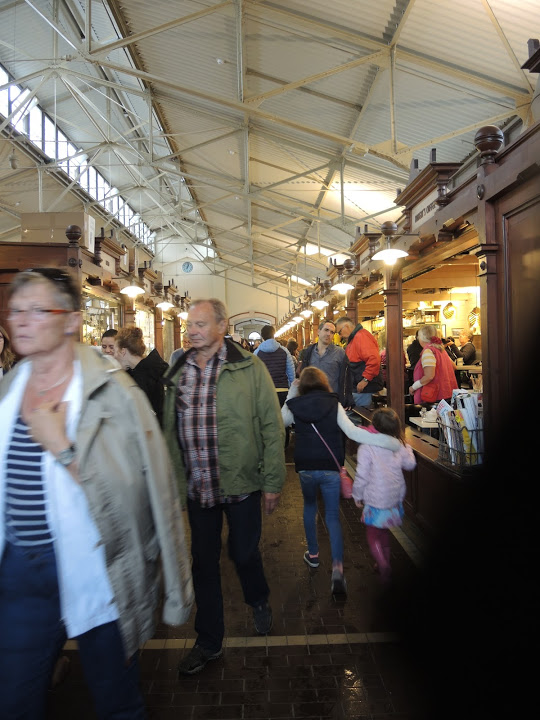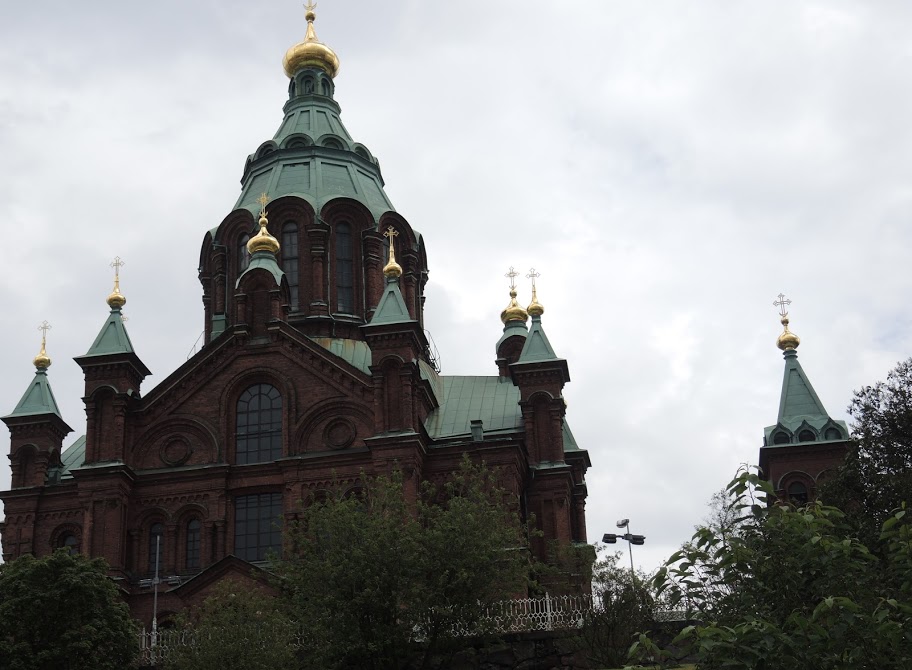I last left you with the image of the hero of our story (me) standing under ominously condensing clouds and bidding farewell in Senate Square to the travelers who had a differently arranged tour agenda in Finland than I. Our guide, Frederick, gathered the 10 people who were returning with him on the ferry to Stockholm that evening to issue his final instructions. We were to be on board no later than 16:30 and we would have reserved tables for the early (17:30) seating at the buffet. He then confirmed that we all knew how to find our way the ship and, satisfied that we did, sent us off to see whatever bits of Helsinki we could in the remaining allotted time.
As we walked back toward the Harbor Market Square, the clouds revealed the purpose of their gathering pouring forth with unexpected intensity that transformed our stroll into a sprint. The rain would continue into the afternoon more mittently than inter.
Fortunately, acting on advice from Pavla’s mother (whose name I have now sadly forgotten) I had my 75 kroner Swedish umbrella with me. As I write this, I feel an urge to stray off topic a bit (so what else is new?). This digression deals with the way distance can create a false sense of the familiar.
Earlier on the trip I experienced a day in Stockholm I thought of as Maryland women’s basketball day. This had nothing to do with basketball or basketball players but came about because, in walking about the city, I had on several occasions walked past two people one of whom I thought strongly resembled the coach’s husband mark and another who looked very much like Jen, the basketball program manager. I find seeing apparently familiar faces in far flung places simultaneously comforting and a bit disorienting.
I had a similar experience when I first saw Pavla. The key difference was that, while her face seemed familiar, I didn’t immediately connect the present face with the familiar but missing one. Determined to make the association, I hoped she wouldn’t notice me staring at her for inappropriately long periods of time. With resolute obstinance, I eventually matched the two faces.
When I realized that I thought Pavla looked like Emily, it made perfect sense that I’d needed time to connect those two women. Emily is someone I see perhaps once a year. She’s married to my (I think) step-nephew David. (David is my brother-in-law’s son from his first marriage and I think this makes him my step-nephew.) The truth probably is that if Emily and Pavla stood side by side I’d find they probably don’t look as much like one another as my internal reality had made them appear. But, at that moment, to me, the resemblance was unquestionable. Perhaps this type of association arises because, as a species, we crave comfort and familiarity and construct these flimsy armatures to fill that need.
Now it’s back to a bit of business that’s tied, in a way, to my previous digression. After the initial downpour had abated and adopted a steady but gentler tone, I strolled past the open-air market to a place somewhat evocative of my hometown of Baltimore.
Sometime in the 18th century and more permanently in the 19th century, a system of municipal markets grew-up throughout that city. The largest and most famous of these was Lexington Market but its smaller siblings, such as the Broadway Market or the Cross Street Market served their neighborhoods varieties of seasonal fruits and vegetables, fresh dairy and baked goods, and housed small butchers and, of course, fishmongers. So, walking in Helsinki, nearly 7000 kilometers from the city of my childhood, I was somewhat delighted to see this building
and I felt even happier when I entered and saw the lines of shops, stalls and eateries.
After slaking my incipient hunger by spending a few euros here and a few more there and patronizing several vendors, I left the indoor market and crossed the square to get a closer look at the Upenski Cathedral.
Those of you who looked at the pictures from my first visit to the Senate Square in the morning might recall a photo of the rather famous Helsinki Cathedral – a building that looks more like an Orthodox Church than the Lutheran Cathedral it is but with good reason. Construction of this building took place in the mid-19th century. It was modeled after St. Isaac’s Cathedral in St. Petersburg and intended as a tribute to Tsar Nicholas I, the Grand Duke of Finland.
His successor, Alexander II, still called “the good tsar” by the Finns, thought it lacked sufficient size and grandeur and ordered it replaced with a more suitable structure. Thus, in 1862, construction began on what our guide told us is the largest Orthodox church in Western Europe. Sitting on a hill in the Katajanokka neighborhood overlooking the harbor and downtown area, the Uspenski Cathedral draws more visitors annually than the cathedral on the square and likely competes with the Temppeliaukio as the most visited religious landmark in the city. Unless photos of the outside count, I was not one of them.
I noted in writing about the morning’s activities that it’s likely only a handful famous Finnish names would be familiar to most Americans mentioning Paavo Nurmi and Jean Sibelius. Two more names who should be at least vaguely recognizable are the father and son architects Eliel and Eero Saarinen.
The elder Saarinen was born in 1873 and remained in Finland until he was 50 years old before emigrating to the United States. His first major design was for the Finnish Pavilion at the 1900 Paris World Fair and he went on to design several important buildings in Helsinki including the National Museum of Finland and the Central Railway Station. I fully intended to visit the latter and to that end started to walk along the famous Esplanadi where, passing through the main shopping district, I was twice interrupted by rain of such ferocity that the only sensible recourse was seeking indoor refuge. Time ticked relentlessly. Eventually, I reached my destination.
The station, which took on a quite different look after Saarinen abandoned his original national romanticist design for a more Nordic interpretation of Art Nouveau architecture, is built almost entirely of Finnish granite. Among its most noteworthy features are the clock tower and the two pairs of stoically expressioned statues that flank the main entrance.
After moving to the United States in 1923, the elder Saarinen’s first major project was the Gulf (now JPMorgan Chase) Building in Houston. This 37-story skyscraper, completed in 1929, was the tallest building in Houston for nearly 35 years. The Kleinhans Music Hall in Buffalo and the Des Moines Art Center stand out among his better-known American work.



